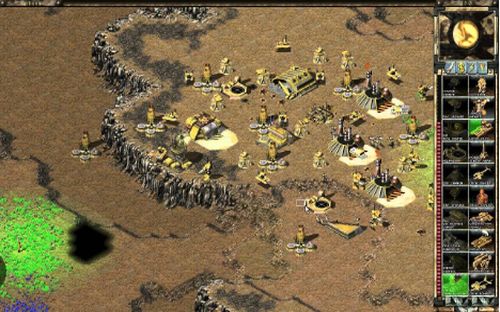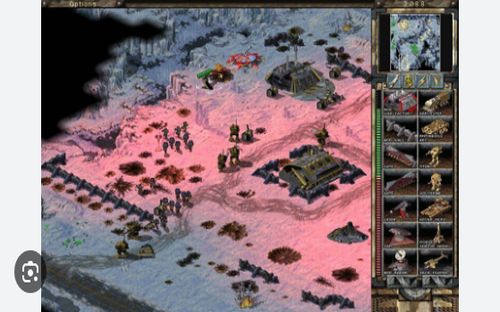Released by Westwood Studios in 1999, Command & Conquer: Tiberian Sun is a major development of the Command & Conquer series and a pillar of real-time strategy (RTS) game. The game immerses players in a dystopian struggle between the Global Defense Initiative (GDI) and the Brotherhood of Nod, set in a dismal, post-apocalyptic future when the extraterrestrial chemical Tiberium has devastated Earth. These groups, which differ in both ideology and strategy, compete for control of tiberium, a resource that is both incredibly hazardous and tremendously precious. In addition to being a continuation of a well-loved franchise, Tiberian Sun represents a technological and conceptual advance, with intricate gameplay mechanics, a compelling plot, and a spooky atmosphere that was unheard of in the genre at the time.
With more sophisticated features including a darker tone, more theatrical storyline, and a deeper tactical layer, the game improves on the original Command & Conquer. The planet of Tiberian Sun, which is set in the 2030s following the events of the first Tiberian Dawn, is marred by environmental deterioration and the development of tiberium. Under the charismatic and enigmatic Kane, Nod thinks Tiberium represents the next stage in human progress, while the GDI aims to control and research the chemical while maintaining human civilization. Players are given a strong feeling of purpose and immersion as the story is developed through a combination of full-motion video (FMV) cutscenes and in-mission briefings, which are fueled by this ideological conflict.

Tiberian Sun’s usage of FMV with well-known Hollywood actors like James Earl Jones and Michael Biehn is one of its most notable features. These performances give the narrative weight and realism, making it seem more like a legitimate science fiction drama than merely a setting for gaming. An innovative idea at the time, the cutscenes are interwoven throughout missions and impact the storyline based on player decisions. With many of storyline twists and a nuanced portrayal of the groups’ internal politics and moral uncertainty, the storytelling is ambitious and captivating. Kane is shown as a visionary with a troubling plan for the future of mankind, and Nod in particular is given a multi-layered storyline that transcends basic villainy.
In terms of gameplay, Tiberian Sun added a number of novel elements. The terrain is no longer only a level battlefield; troops may now strategically exploit height, and destructible environments give the action a more realistic feel. Gameplay is impacted by dynamic lighting and weather events, such as ion storms and night missions, which frequently disable specific technology and require players to adjust. The game seemed more dynamic and responsive because to this degree of environmental involvement, which was revolutionary at the time. Deployable structures, underground forces, and a variety of advanced superweapons were available to players, enabling adaptable tactics and unforeseen battle situations.
The two primary factions’ designs demonstrate Westwood’s dedication to asymmetrical balance. The forces of GDI are more conventional, well armored, and depend on firepower and raw force. Their Mammoth Mk. II walkers and Titan mechs are formidable vehicles built for front-line control. Nod, however, uses psychological warfare, quickness, and stealth. Nod players can use cyborg troops, chemical weapons, and cloaked forces to carry out subversion and guerilla warfare. Experienced players’ battles can be frantic, unexpected, and highly tactical due to their fundamentally different playstyles, as both teams attempt to take advantage of each other’s shortcomings.
Tiberian Sun was a major advancement in graphics. The game used a more subdued, somber color scheme that was more appropriate for the dystopian theme, even though it still used 2D sprites in an isometric format. Each combat seemed more realistic and theatrical because of the lighting effects, day-night cycles, and striking environmental destruction. The game’s distinctively gloomy atmosphere was enhanced by the futuristic design, which featured biomechanical components and bizarre, crystalline landscapes tainted by Tiberium. A change in tone was also evident in Frank Klepacki’s music, which shifted from the strong rock of previous installments to a more evocative, synth-laden sound that reflected the game’s darker themes.



Tiberian Sun’s multiplayer feature gave the game much more depth. Players were able to test their techniques against other players in real time while playing online through Westwood Online. The game’s existence was extended much after its initial release thanks to a robust community of modders and fans fostered by a map editor and the option to build unique missions. Although the community was always debating how to maintain balance between sides, the diversity of unit types and strategies made sure that no two battles felt the similar. One of the game’s best features was that it could be played again, and many enthusiasts kept playing it long into the 2000s.
System Requirements OF Command and Conquer Tiberian Sun Highly Compressed PC
| Ram | 32 MB RAM |
|---|---|
| Processor | Pentium |
| Accessories | Keyboard, mouse, and speaker |
| Graphics card | NVIDIA RIVA TNT2 |
| Windows | Xp, 7, 8, 8.1, 10, and 11 |
| Free disk space | 1.2 GB |
The way that Tiberian Sun combined science fiction ideas with contemporary concerns is among its more intriguing features. Concerns about unbridled technological development and environmental deterioration are reflected in the rise of tiberium as a resource and a pollutant. Kane’s transhumanist philosophy foreshadows current discussions over human development, artificial intelligence, and the social use of biotechnology. Through its missions and narrative beats, the game delicately examines these topics, posing queries about what it means to live and change in a planet that has been drastically altered by an enigmatic extraterrestrial substance.
Tiberian Sun has shortcomings despite its aspirations. The game had several bugs and performance problems when it was first released. Additionally, several commentators pointed out that pathfinding for units may occasionally be unpleasant and that the AI was unreliable. Some competitive disputes resulted from GDI and Nod’s balance difficulties. Over time, fan communities developed unofficial mods and solutions that enhanced the experience, and updates solved many of these issues. Despite its flaws, the game’s tone and vision made an impact on gamers and solidified its position in the RTS canon.
The legacy of Tiberian Sun is one of inventiveness, aspiration, and nuanced storytelling. In terms of plot, gameplay, and atmosphere, it stretched the limits of what RTS games could provide. It was a dramatic and conceptual experience that immersed players in a grim, hypothetical future; it was more than simply a strategy game. Tiberian Sun continues to be a favorite among fans because of its courage to take chances and produce something daring, even when subsequent Command & Conquer games would improve upon or depart from its concept. It remains as a reminder that narrative, ambiance, and philosophical interest can all be found in the regimented gameplay of role-playing games.


